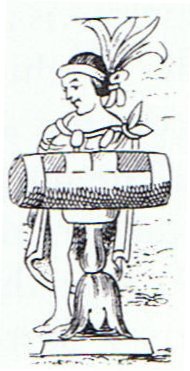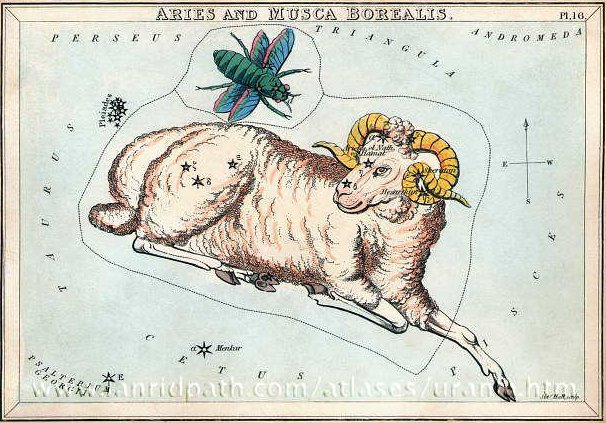Depending on the era the northern spring equinox would be
connected (bound with a knot) to different significant stars.
When the era was changed (because it could be observed that the precession had moved the
Sun much too early as perceived against the fixed stars) it
meant the knot would have to be opened up and then all the fixed stars would
suddenly be allowed to move ahead in unison due to the new place
for 0h.
The sky was moving (rutua te maeva), said Metoro, which may have been meant to indicate such a change in the position of
0h.
|
ki te henua - tagata honui |
391 |
te pahu |
|
 |
 |
  |
|
Ca1-6 |
Cb1-6 (6 +
392) |
|
λ Phoenicis (6.3),
β Tucanae (6.4)
*6.4 - *41.4 + *366.0 = *331.0
= *148.0 + '183.0 |
ξ¹
Ceti
(32.1) |
|
γ
Muscae (189.0),
AVIS SATYRA (Bird of the Satyrs) =
η
Corvi
(189.3),
ASTERION (Starry) =
β
Canum Ven.
(189.5),
KRAZ = β Corvi,
κ Draconis (189.7)
*331 - *183 = *148 = *189 - *41 |
Al Ghafr-13 (The Cover) /
Svāti-15 (Very Good) /
TAHUA-TAATA-METUA-TE-TUPU-MAVAE-6 (a pillar to
stand by)
15
Bootis
(215.2),
ARCTURUS =
α
Bootis
(215.4),
ASELLUS SECUNDUS (2nd Ass Colt) = ι Bootis
(215.5),
SYRMA (Train of the Virgin's Robe) =
ι
Virginis,
λ
Bootis (215.6),
η
Apodis (215.8)
*174.0 = *215.4 - *41.4 = *148 + *26 |
|
Egyptian djed |
 |
Phoenician
sāmekh |
 |
Greek
xi |
Ξ (ξ) |
|
... In rongorongo times the last
Greek lettered star in
Orion (ξ)
rose with the Sun in June 21. The letter seems to
have originated from the Phoenician letter samekh
(tent peg, supporting prop), which in turn may have
been derived from the ancient Egytian djed
column ...
 |
|
rutua te maeva |
atua rerorero |
atua hiko ura |
hiko o tea |
|
Maeva. T. 1. Move. Rangi-maeva
= Moving Sky (name of a marae). 2. Greet, greeting.
Henry.
Rerorero. 1. To write, to draw; rerorero i
te igoa, to sign. 2. To rape. Vanaga. To crush, to
bruise. Churchill.
Hiko.
1. To ask (for something). 2. To filch, to pilfer.
Hikohiko, to snatch by force; robbery by assault.
Vanaga. Hikohiko keke, hide-and-seek. Churchill.
Pau.: 1. To glean. Mgv.: kohi, to gather, to
collect. Ta.: ohi, to glean. Mq.: kohi,
id. Ma.: kohi, to gather. 2. Bamboo. Mgv.:
kohe, id. Ta.: ohe, id. Mq.: kohe, id.
Sa.: 'ofe, id. Ma.: kohe, a plant name. 3.
Diarrhea. Ta.: ohi, dysentery. Churchill. Mgv.:
kohiko, a small bag mounted in the fruit-picking
fork.
Mq.: kohiko, a small net. Churchill. |
|
 |
 |
 |
 |
|
Cb1-7 |
Cb1-8 (400 = 366 + 34) |
Cb1-9 |
Cb1-10 |
|
γ,
δ
Trianguli (33.0),
χ
Persei (33.2),
10
Trianguli
(33.5),
θ
Arietis (33.3),
MIRA (Astonishing) =
ο
Ceti
(33.7) |
No star listed (34) |
ξ Arietis (35.0),
ρ Ceti (35.4),
12
Trianguli
(35.8), ξ² Ceti (35.9)
*360.0 = *35.4 - *41.4 |
σ Ceti (36.9) |
 |
|
ι Lupi,
18 Bootis
(216.3),
KHAMBALIA (Crooked-Clawed) = λ Virginis
(216.4),
υ Virginis (216.5), ψ Centauri (216.6), ε Apodis (216.8)
*175.0 = *216.4 - *41.4 |
ASELLUS
PRIMUS (1st Ass Colt) = θ Bootis
(217.8) |
τ
Lupi,
δ
Oct. (218.1),
φ
Virginis (218.7)
FOMALHAUT (α Piscis Austrini) |
σ
Lupi (219.1),
ρ
Bootis (219.5),
HARIS
(Keeper) = γ Bootis
(219.7) |
|
ka higa te ao ko te henua ra ma
te hoi atua |
manu rere - kua
rere ga manu - ki te ragi |
|
Hoki. To return, to
go back, to come back; ka hoki ki rá,
go back there! ana oho koe ki Hiva, e hoki mai ki
nei, if you go to the mainland, do come back
here again. Vanaga. 1. Also, what; ki ra hoki,
precisely there; pei ra hoki, similitude,
likeness; pei ra hoki ta matou, usage. P
Pau.: hokihoki, often. Mgv.: hoki,
also, and, likewise. Mq.: hoi, surely. Ta.:
hoi, also, likewise. 2. To return, to turn
back, to draw back, to give back, to tack; mau e
hoki mai, to lend; hoki hakahou, to carry
back; hoki amuri, to retrograde; hakahoki,
to bring back, to send back, to carry back, to
restore, to renew, to revoke, to remove, to dismiss,
to pay, to pardon, to compress; hakahokia,
given up; hakahokihaga, obligation. P Pau.:
hokihoki, to persist, to insist; fakahoki,
to give back. Mgv.: hoki, to return, to
retrace one's steps; oki, to return, to come
back. Ta.: hoi, to return, to come back. Ta.:
mahoi, the essence or soul of a god.
Churchill.
Rere. To jump; to run; to fly.
Rere-taúra, to carry a child astride on one's
shoulder: ku rere-taúra-á i te poki e te matu'a
ki te gao, the mother carries her child astride
her neck. Vanaga. 1. To fly, to run, to leap, to
scale, to be carried away by the wind; ika rere,
flying fish; rere aruga, to rebound; hetuu
rere, meteor, flying star. Hakarere, to
leap. P Pau.: rere, to soar, to fly;
fakarere, to precede. Mgv., Ta.: rere, to
fly, to leap. 2. To come, to reach to. Mq.: éé
mai, to come. 3. To swerve, to deviate. (4.
Hakarere, to cease, desist, postpone, quit,
vacation; tae hakarere, perseverance. Mq.:
rere, to disappear. 5. Hakarere, to save,
preserve, put, place, reserve, burden, destine. 6.
Hakarere, to abandon, forsake, give up,
depose, expose, leave, omit, abjure, repudiate;
hakarere ki te hau, uncover the head;
hakarere ki te vie, to divorce, hakarere ki
raro, to put down, tooa te kiko e ivi i
hakarere, to strip off the flesh. Mq.: éé,
to run away, to escape. 7. Hakarere?
Ikapotu hakarere, to abut, to adjoin; e tahi
hakarere, synonym.) Churchill. Vi.: Lele,
the end of a branch farthest from the body of a
tree; leletha, to bend a branch in order to
gather the fruit on it. Churchill 2. In the present
phase of Polynesian lele so much means to fly
that the plainest way of particularizing birds is to
describe them as the flying animals, manulele.
But to manifest that flight, an exercise or
balancing of wings, was by no means the primordial
sense, for how could that give rise to a description
of water in the water-courses? It will be no end to
mass the several significations which lele
exhibits ... Flight of birds ... Wind drive ...
Meteors ... To leap ... To run ... Flow of water ...
To swim ... To sail ... These several activities are
exercised in earth, air, and water. The common
factor is the swift motion. The means of motion cut
no figure. It is an invisible means in the driving
of the wind, the flash of the meteor silent athwart
the sky on its lethal errand, the slip and slide of
the stream in its deep course, the set of the sea,
the gliding of the canoe upon its surface. Churchill
2. |
|
 |
 |
|
Cb1-11 (403) |
Cb1-12
(4 * 101) |
|
CLOSE
TO THE SUN: |
|
27 (117 = 91 + 26) |
April 28
(118 = 4 * 29½) |
|
ν Ceti (37.9) |
ν Arietis (38.5), δ, ε Ceti (38.8) |
|
CLOSE TO THE FULL MOON: |
|
σ Bootis (220.2),
η Centauri (220.4)
*179.0 = *220.4 - *41.4 |
ρ Lupi (221.0),
TOLIMAN = α Centauri
(221.2), π Bootis (221.8), ζ Bootis (221.9) |
|
Oct 27 (300 = 273 = 3 * 91) |
28 |
 |
Counting from the very special Cb1-16 (→
4 * 29) and 16 days
ahead we will find April 28. In the G text the
corresponding very special Gb7-30 (→
210) was connected with
FEBRUARY 17:
|
FEBR 17
(413 = 477 - 64) |
18 (414 = 365 + 49) |
|
 |
 |
|
Gb7-30
(440 = 229 + 211) |
Gb7-31
(63 weeks = 414 + 27) |
|
ξ¹
Ceti
(32.1) |
γ,
δ
Trianguli (33.0),
χ
Persei (33.2),
10
Trianguli
(33.5),
θ
Arietis (33.3),
MIRA (Astonishing) =
ο
Ceti
(33.7) |
|
April 22
(365 + 112 = 477) |
23 (113) |
|
°April 18 (473) |
19 (109) |
|
'March 26
(450) |
27 (86) |
|
"March 12
(436) |
13 (72) |

The Back of the Head of Ku (the
2nd Babylonian ecliptic constellation) was at
Hamal and the Front of
the Head of Ku was at Sheratan. Possibly the idea of the
front of a head coming first and the back of a head 3 days later
once upon a time had been tranferred from Cetus to Aries. Which
would explain why the head of Aries usually was depicted as
turned around:

For anciently
it was probably the Full Moon (going withershins, rising in the
west and descending in the east) who had its face coming first.
Waxing Moon grew first and then came Waning Moon.
 |
 |
 |
 |
 |
|
Cb1-1 (393) |
Cb1-2 |
Cb1-3 |
Cb1-4 (396) |
Cb1-5 |
|
April 17 (91 + 16)
Al Sharatain-1 /
Ashvini-1 /
Bond-16 (Dog) /
Mahrū-sha-rishu-ku-1 (Front of the Head of Ku)
SEGIN = ε
Cassiopeia, MESARTHIM = γ Arietis, ψ Phoenicis
(27.2),
SHERATAN (Pair of Signs) = β Arietis, φ
Phoenicis (27.4)
*351.0
= *27.4 - *41.4 |
18
(108)
ι Arietis (28.0), λ Arietis (28.2), υ Ceti (28.8) |
19
ALRISHA (The Knot) = α Piscium,
χ Phoenicis (29.2),
ε Trianguli (29.4), ALAMAK (Caracal) = γ
Andromedae
(29.7)
*353.0
= *29.4 - *41.4 |
20
Arku-sha-rishu-ku-2 (Back of the Head of Ku)
2h (30.4)
κ Arietis (30.3),
HAMAL (Sheep) = α Arietis
(30.5)
ALKES (α
Crateris) |
21 (111)
DELTOTUM =
β Trianguli
(31.2), ι Trianguli (31.7), η Arietis (31.9) |

|



















